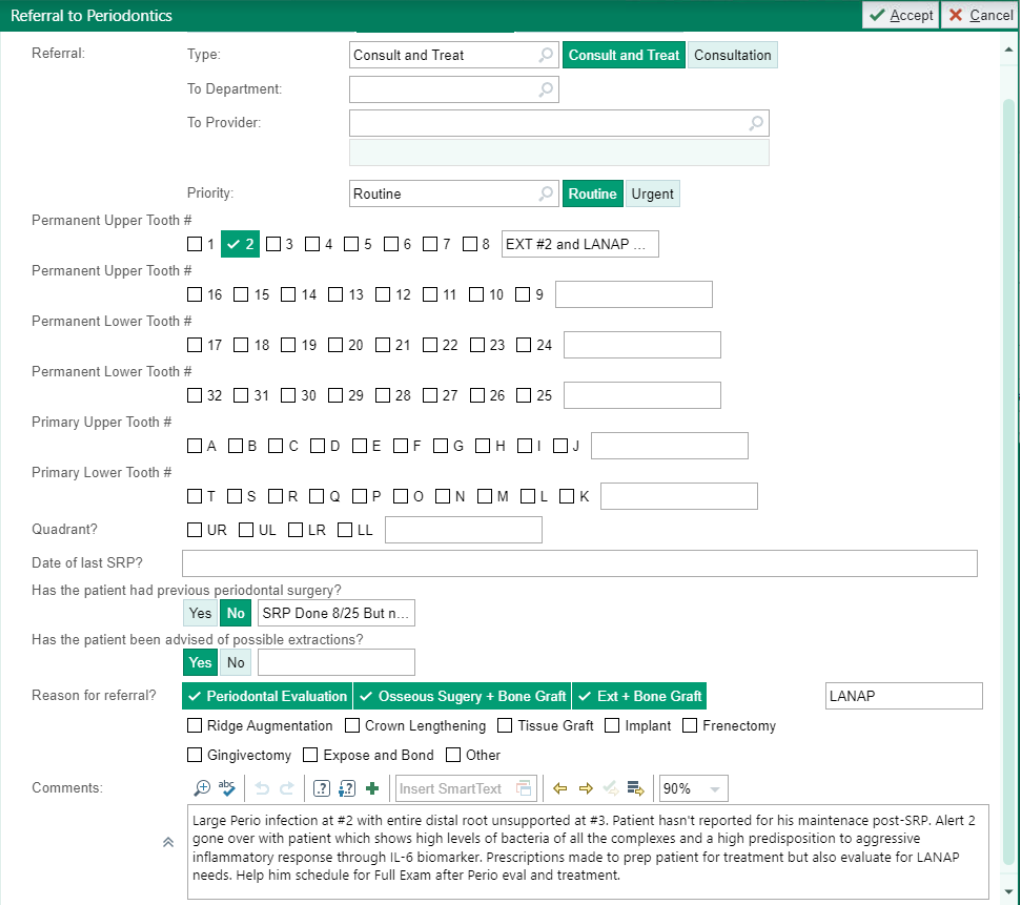 Challenge: Addressing the unique needs of a patient with a history of hesitancy towards dental care, compounded by complex health issues such as Tobacco Dependence Syndrome, Hypertension, and Prediabetes, presented a significant challenge. This task, however, was greatly facilitated by the integration of CBCT/OralDNA® technologies.
Challenge: Addressing the unique needs of a patient with a history of hesitancy towards dental care, compounded by complex health issues such as Tobacco Dependence Syndrome, Hypertension, and Prediabetes, presented a significant challenge. This task, however, was greatly facilitated by the integration of CBCT/OralDNA® technologies.
These cutting-edge tools played a pivotal role in demystifying the pathos process, enabling a more clear and personalized approach to the patient’s treatment plan. Notably, this newfound understanding of their disease process has been empowering for the patient. Previously reluctant, they are now actively engaged and motivated to lower their oral bacterial load by any means necessary. This shift towards a proactive stance in their oral health care is a testament to the transformative power of patient education and technological advancement in dental care.
Background:
Age: 44-Year-Old
Sex: Male
Medical History: Secondary diagnoses including depression, gastroesophageal reflux disease, hyperlipidemia, bilateral hip pain, PTSD, and prediabetes.
Last Dental Exam: One year ago. Patient was seen for a New Patient Exam where Non-Surgical Periodontal Treatment was done through the Hygiene Department. Since then, the patient has not reported for their follow up appointments with our Periodontist and their regular maintenances. His wife’s persistent efforts to encourage dental visits finally culminated in success when the patient, driven by acute discomfort, agreed to attend today’s emergency appointment.
Home Care: Tendency to overlook regular oral hygiene practices.
Clinical Assessment: History of Non-Surgical Periodontal Therapy through Hygiene department and missed appointments with Perio for follow up. The patient reported for an Emergency with severe pain in the Upper Right Quadrant. Although the patient had paid for his first maintenance appointment on his Scaling and Root Planning visit, the patient had not reported for any follow up visits.
Medical Assessment: Hemoglobin A1C at 5.9, indicating reasonable blood sugar control. Other notable results found through EPIC include vitamin D levels, a comprehensive metabolic panel, lipid panel, thyroid stimulating hormone (TSH) levels, and a complete blood count (CBC), with some values outside normal ranges.
Case: On his Emergency Visit, the patient was shown their Alert 2™ results gathered a year ago, which revealed a significantly high bacterial load across the different complexes and high IL-6 biomarker, indicating a high predisposition to aggressive inflammatory response to Periodontal Disease.
This was in line with the patient’s Chief Concern of Pain of the URQ due to a Periodontal abscess.
A referral was made to our Perio Department to treat #2 via Exodontia and Alveolar Ridge Preservation with Bone graft and Membrane Procedures and LANAP Treatment.
Solution: Patient has been managed through Perio with Removal of site #2 and LANAP treatment. The patient is scheduled for re-evaluation with GP for further OralDNA testing. This previously reluctant patient reports motivated to lower his bacterial load by any means necessary.
Summary: The case highlights how CBCT/OralDNA technologies empower teams to demystify the pathophysiological process for patients, even to the most reluctant of patient groups.
- Revolutionizing Periodontal Disease Screening and Treatment with OFC and Alert 2™ Diagnostics - October 25, 2024
- Dr. Benavides: “Did We Overtreat: The Value of Proactive Intervention for the Periodontal Patient.” - August 23, 2024
- A Dental Detective Story – When a 102% Surge in Bacterial Load After Scaling Unveils a Horizontal Transmission Tale - April 5, 2024




